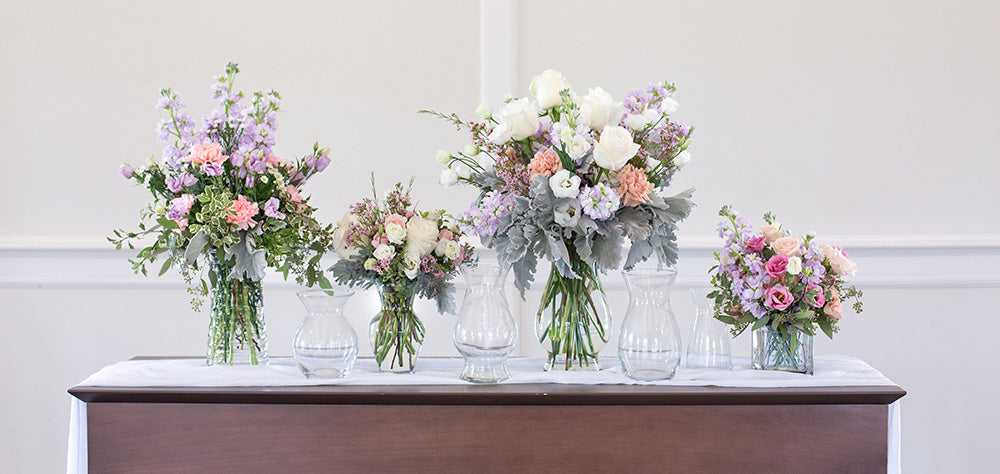Have you ever noticed how many different shapes you can create when designing flower arrangements? They can be tall or short, symmetrical or asymmetrical, round or straight. Many things help you create the shape you want for your final product, but the vase shape you choose will help you the most.
There are many different types of vases for flowers. When arranging flowers in a vase, you must work with its shape. You can’t create a tall, full centerpiece in a bud vase, and a single orchid will look odd in a wide bowl vase. Read this guide to learn more about how different types of vases shape your floral arrangements and how to pick the perfect vase to help you achieve the design you have in mind.
The Many Types of Vases for Flowers

Peruse the inventory of any vase seller, and you’ll find vases in a wide variety of sizes, shapes, and materials. Learning more about the different types of materials vases come in and their benefits will help you as you make your decision for the style. All of these beautiful vases might feel overwhelming if you don’t know what you’re looking at. Learning the names of vase types will help you recognize the different styles and pick the right vase for your project. Here are some of the most popular flower vase shape names:
Bouquet vases like the Ceramic Essential Vase have a wide base and flared top capable of holding large displays of flowers and foliage.
Cylinder vases are tall, narrow vases with straight sides for holding long-stemmed blooms.
Trumpet vases are tall with a narrow base and a wider flared opening for holding tall, lush arrangements.
Jar vases such as the Hammered Jar Glass Vase, have a broader base and slightly tapered neck for supporting large bouquets.
Pedestal vases have a narrow base and wide top, making them ideal for formal floral centerpieces that seem to spill out over the edges.
Compote vases are wide, bowl-shaped vases perfect for sprawling floral arrangements or floating flowers and are typically used for reception centerpieces.
Bulb vases have a very wide bottom to hold plenty of water for bulbs or hydroponic plants and a narrow neck for supporting the plant.
Bud vases are small, narrow vases meant for holding a single flower or tiny bouquet.
Bottle vases are usually tall with a dramatically narrower neck like a bottle.
How the Vase Shape Affects the Final Arrangement

What shape are you envisioning for your flower arrangement? Be sure to choose a vase whose design helps you create that shape.
No matter the shape, every vase has a base it sits on, sides, and an opening. The shape of these parts influences how flower stems fit inside them. If any part is narrow, it will hold stems together tightly. Think about a tall and narrow cylinder vase. The narrow bottom and opening will only hold a few stems, and the straight sides hold them upright.
Wide vase parts give stems more room to sit at different angles. A broad urn or bowl vase lets flowers lay at angles so it looks like they are spilling over the sides. Wide-mouth jar vases let flowers hang over the edge for a fuller-looking bouquet.
Of course, not every vase is entirely narrow or wide. Some vases have both wide and tapered parts for creating beautiful arrangement shapes. Trumpet vases have a narrow base but wide opening to hold an abundance of flowers at angles that create a round arrangement on top. Bulb vases are narrow in the middle to hold a flower bulb and wide at the base to hold ample water for the roots. With so many vases to choose from, your options for beautiful flower arrangements are endless!
How to Pick the Right Vase Shape

Bud vases are ideal for small, whimsical flower arrangements or single flowers.
When conceptualizing a floral arrangement, you may already have a type of vase in mind. But while the vase looks beautiful, you also need it to help shape your floral design. Fortunately, there are many vase styles out there to choose from. The more you experiment with different vase shapes, the more you’ll understand how they influence your final arrangement shape. To help you get started, here’s a brief overview of how to use common vase shapes.
Bouquet vases work best for lush bouquets with lots of flowers. Their hourglass shape lets you play with stem angles and stabilizes the whole arrangement.
Cylinder vases hold long-stemmed blooms in a tight bunch, making it easy to create a tall, symmetrical arrangement. They also look elegant when holding a single show-stopping flower.
Trumpet vases also work best for long-stemmed flowers, but their flared top lets you create large arrangements with flowers at different angles for beautiful shapes.
Jar vases hold stems upright but have a wide opening that lets you angle stems and create full-looking arrangements.
Bowl vases let you make expansive, full arrangements. Their broad openings allow stems to sit at many angles and hang over the edge to create interesting short arrangement shapes.
Pedestal vases work similarly to bowl vases, but their narrow base gives the arrangement some height.
Bulb vases work best for flowering bulbs with thick, straight stems. These wide-based vases also prevent top-heavy blooms from tipping over.
Bud vases are small, so use them to showcase a single bloom or mini spray of flowers. You can also group several bud vases together to create a lovely centerpiece or vignette.
Bottle vases are perfect for a single tall flower or an arrangement of a few blooms with thin, long stems.
Prepping Flowers for Vases of Different Shapes

The Holly Chapple Pillow secures stems in place as you build a beautifully-shaped floral arrangement.
It takes more than picking the right vase to achieve the floral arrangement shape you want. The flowers matter too. Use these tips to prep flowers to fit in your chosen vase.
Shop 46 & Spruce for Stylish Vases
Feeling inspired to try some new vase shapes? 46 & Spruce has a wide variety of beautiful vase styles for creating show-stopping floral arrangements. Order individual products or sign up for a Professional account today to access bulk ordering and discounts. Have questions? Our knowledgeable customer service representatives are happy to help when you contact us.

